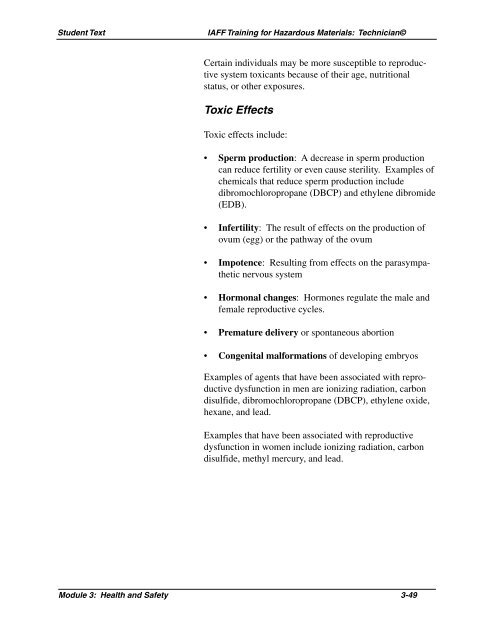Module 3: Health and Safety - IAFF
Module 3: Health and Safety - IAFF
Module 3: Health and Safety - IAFF
Create successful ePaper yourself
Turn your PDF publications into a flip-book with our unique Google optimized e-Paper software.
Student Text <strong>IAFF</strong> Training for Hazardous Materials: Technician©<br />
Certain individuals may be more susceptible to reproductive<br />
system toxicants because of their age, nutritional<br />
status, or other exposures.<br />
Toxic Effects<br />
Toxic effects include:<br />
• Sperm production: A decrease in sperm production<br />
can reduce fertility or even cause sterility. Examples of<br />
chemicals that reduce sperm production include<br />
dibromochloropropane (DBCP) <strong>and</strong> ethylene dibromide<br />
(EDB).<br />
• Infertility: The result of effects on the production of<br />
ovum (egg) or the pathway of the ovum<br />
• Impotence: Resulting from effects on the parasympathetic<br />
nervous system<br />
• Hormonal changes: Hormones regulate the male <strong>and</strong><br />
female reproductive cycles.<br />
• Premature delivery or spontaneous abortion<br />
• Congenital malformations of developing embryos<br />
Examples of agents that have been associated with reproductive<br />
dysfunction in men are ionizing radiation, carbon<br />
disulfide, dibromochloropropane (DBCP), ethylene oxide,<br />
hexane, <strong>and</strong> lead.<br />
Examples that have been associated with reproductive<br />
dysfunction in women include ionizing radiation, carbon<br />
disulfide, methyl mercury, <strong>and</strong> lead.<br />
<strong>Module</strong> 3: <strong>Health</strong> <strong>and</strong> <strong>Safety</strong> 3-49
















